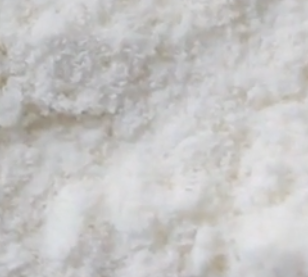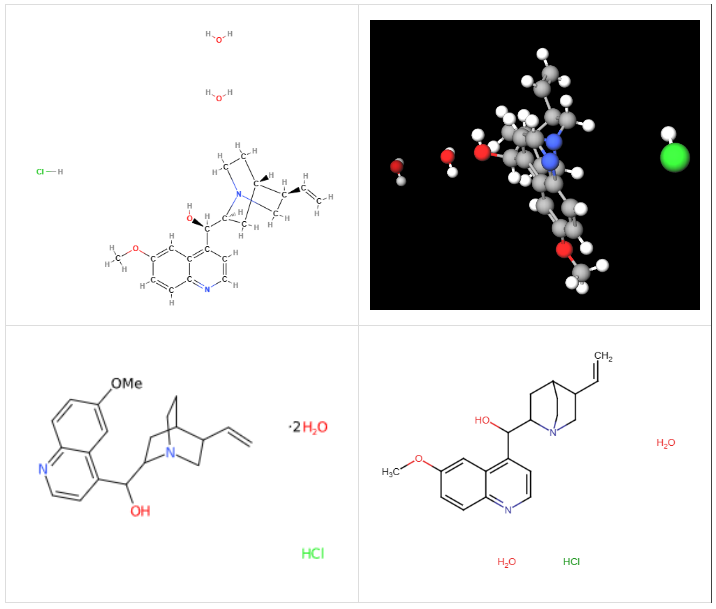| "Descrizione" by Nat45 (5724 pt) | 2023-Jun-27 20:19 |
Review Consensus: 10 Rating: 10 Number of users: 1
| Evaluation | N. Experts | Evaluation | N. Experts |
|---|---|---|---|
| 1 | 6 | ||
| 2 | 7 | ||
| 3 | 8 | ||
| 4 | 9 | ||
| 5 | 10 |
Quinine monohydrochloride dihydrate or Quinine monochloride dihydrate is a salt obtained chemically from quinine. Quinine is an alkaloid from the bark of the China tree, family Rubiaceae. Three salts are obtained from quinine: FL 14,011, FL 14,152 and FL 14,155, and the latter is what is called Quinine monochloride dihydrate. The specific properties of Quinine monochloride dihydrate, such as solubility and stability, may vary depending on storage and usage conditions.
Quinine occurs naturally in the bark of the cinchona tree and was the first effective western treatment for malaria.
The name defines the structure of the molecule:
- Quinine is the natural compound found in the bark of the cinchona tree. Quinine has been used for centuries as a treatment for malaria because of its ability to kill disease-causing parasites.
- Monochloride refers to a compound containing a chlorine atom. In the context of quinine monochlorine, it means that a chlorine atom is attached to the quinine molecule.
- Dihydrate refers to a compound that has two water molecules (H2O) associated with each formula unit of the compound. In the context of quinine monochlorine dihydrate, it means that two water molecules are associated with each molecule of quinine monochlorine.
The synthesis process takes place in several stages:
- Extraction of quinine from the bark of the Cinchona tree.
- Reaction. The extracted quinine is reacted with hydrochloric acid to form quinine hydrochloride.
- Crystallization. Quinine hydrochloride is crystallized in the presence of water to form monochlorinated quinine dihydrate.
Monochlorinated quinine dihydrate is a solid at standard temperature and pressure (STP), with a melting point of 115.5 ºC. It is typically found in powder form. The color may vary depending on its purity and the specific production process, but it is typically white or off-white.

What it is used for and where
Food
It is used in drinks and some foods to impart a bitter taste.
Contraindications - studies
Glucose-6-phosphate dehydrogenase (G6PD) deficiency is the most common human enzyme defect that often appears in neonatal jaundice and/or haemolytic anaemia. G6PD haemolytic events are linked to exposure to a pro-oxidant agent. Here we report three cases of initial G6PD crises in breastfed infants with maternal consumption of a tonic drink containing quinine. Quinine was found in the breast milk of one of the mothers after consuming tonic water. The amount of quinine that is transmitted through breast milk appears to be sufficient to induce G6PD seizures in breastfed infants. Therefore, it is recommended to avoid consumption of quinine-containing drinks during breastfeeding in populations with a high prevalence of G6PD deficiency.
What is known:
- G6PD haemolytic events are linked to exposure to a pro-oxidant agent.
- The ingestion of fava beans by a mother who was breastfeeding induced a neonatal G6PD crisis.
What's new:
- maternal consumption of a tonic drink containing quinine appears to be sufficient to induce G6PD seizures in breastfed infants.
- Maternal consumption of quinine-containing drinks during breastfeeding should be avoided in populations with a high prevalence of G6PD deficiency (1).
Quinine is a common cause of drug-induced thrombocytopenia and the most common cause of drug-induced thrombotic microangiopathy. Other quinine-induced systemic disorders have been described. In order to understand the full clinical spectrum of adverse reactions to quinine, the author of this study consulted 11 databases that provided sufficient data to allow evaluation of levels of evidence supporting a causal association with quinine. Three reviewers independently determined levels of evidence, including both immune-mediated and toxic adverse reactions. The main focus of this review was on acute, immune-mediated reactions. The source of quinine exposure, organ systems involved, severity of adverse reactions and patient outcomes were documented. One hundred and fourteen articles described 142 patients with definite or probable evidence of a causal association of quinine with acute, immune-mediated reactions. One hundred and nine (72%) reactions were caused by quinine pills; 28 (20%) by quinine-containing beverages; 12 (8%) by five other types of exposure.Quinine, even with minimal exposure from common beverages, can cause severe adverse reactions involving multiple organ systems. In patients with acute, multisystem disorders of unknown origin, an adverse reaction to quinine must be considered (2).
European legislation has dealt with this substance (3) in order to assess its effects on human health and, in the opinion of the Scientific Committee on Food (SCF) of 19 February 1988, no objections were raised, from a toxicological point of view, to the continued use of quinine in bitter drinks at current levels (up to a maximum of 100 mg/l). While not contesting this assessment, the Authority recommends a review of the toxicological database on quinine (4). Pending the re-evaluation of quinine, the use of three quinine salts (FL 14.011, FL 14.152 and FL 14.155) should be restricted to non-alcoholic and alcoholic beverages.

- Molecular Formula C20H29ClN2O4
- Molecular Weight : 396.91
- CAS : 6119-47-7
- EC number 231-437-7
- UNII 711S8Y0T33
Synonyms :
- 60-93-5 (.2HCl)
- AKOS025310495
- BIQ1204
- CHEMBL3706390
- Chinini hydrochloridum
- Cinchonan-9-ol, 6'-methoxy-, monohydrochloride, dihydrate, (8a,9R)-
- CS-2539
- DTXSID2047694
- FL 14.155
- HY-B0433A
- KS-000010VZ
- LS40029
- MFCD00078498
- MolPort-003-926-508
- Quinine HCl Dihydrate
- QUININE HYDROCHLORIDE DIHYDRATE
- Quininehydrochloride,dihydrat
- S2502
- SC-05720
- ZX-AFC000703
References_____________________________________________________________________
(1) Bichali S, Brault D, Masserot C, Boscher C, Couec ML, Deslandes G, Pissard S, Leverger G, Vauzelle C, Elefant E, Rozé JC, Cortey A, Chenouard A. Maternal consumption of quinine-containing sodas may induce G6PD crises in breastfed children. Eur J Pediatr. 2017 Oct;176(10):1415-1418. doi: 10.1007/s00431-017-2998-5.
(2) Liles NW, Page EE, Liles AL, Vesely SK, Raskob GE, George JN. Diversity and severity of adverse reactions to quinine: A systematic review. Am J Hematol. 2016 May;91(5):461-6. doi: 10.1002/ajh.24314.
(3) «Report of the Scientific Committee for Food on Quinine.» (19 February 1988). In Food — Science and techniques. Reports of the Scientific Committee for Food (Twenty-first series).
(4) «Scientific Opinion of the Panel on Food Additives, Flavourings, Processing Aids and Materials in Contact with Food on a request from Commission on Flavouring Group Evaluation 35, (FGE.35) Three quinine salts from the Priority list from chemical group 30.»EFSA Journal (2008) 739, pagg. 1-18.
| Evaluate |

